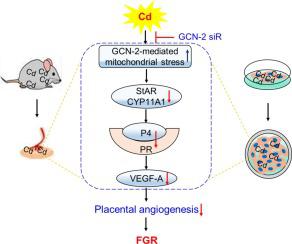Journal of Hazardous Materials ( IF 13.6 ) Pub Date : 2020-07-08 , DOI: 10.1016/j.jhazmat.2020.123438 Yong-Wei Xiong 1 , Xiao-Feng Xu 2 , Hua-Long Zhu 1 , Xue-Lin Cao 1 , Song-Jia Yi 1 , Xue-Ting Shi 1 , Kai-Heng Zhu 1 , Yuan Nan 1 , Ling-Li Zhao 1 , Chen Zhang 1 , Lan Gao 1 , Yuan-Hua Chen 1 , De-Xiang Xu 1 , Hua Wang 1

|
Cadmium (Cd), a well-known environmental pollutant, can lead to placental insufficiency and fetal growth restriction. However, the underlying mechanism is unknown. The purpose of our study is to explore the effect of Cd on placental angiogenesis and its mechanism using in vitro and in vivo models. Results found that gestational Cd exposure obviously decreased placental weight and impaired placental vascular development in mice. Correspondingly, Cd exposure evidently downregulated the expression of VEGF-A protein (a key indicator of angiogenesis) and progesterone receptor (PR) in placental trophoblasts. Further experiment showed that lentivirus PR overexpression reversed Cd-caused the reduction of VEGF-A level in human placental trophoblasts. In addition, Cd significantly reduced progesterone level, down-regulated the expression of key progesterone synthase (StAR, CYP11A1), and activated mitochondrial stress response and GCN-2/p-eIF2α signaling in placental trophoblasts. Additional experiment showed that GCN-2 siRNA pretreatment markedly alleviated Cd-activated mitochondrial stress response, restored Cd-downregulated the expression of CYP11A1, reversed Cd-reduced the level of progesterone and VEGF-A in human placental trophoblasts. Finally, our case-control study confirmed that impaired placental angiogenesis and reduced progesterone level occurred in all-cause small for gestational age placenta. Taken together, environmental exposure to Cd impairs fetal growth and placental angiogenesis via GCN-2-mediated mitochondrial stress.
中文翻译:

镉暴露于环境中会通过GCN-2介导的线粒体应激损害胎儿生长和胎盘血管生成。
镉(Cd)是一种众所周知的环境污染物,可导致胎盘供血不足和胎儿生长受限。但是,其潜在机制尚不清楚。我们研究的目的是使用体内和体外模型探讨Cd对胎盘血管生成的影响及其机制。结果发现,妊娠Cd暴露可明显降低小鼠胎盘重量,并损害胎盘血管发育。相应地,Cd暴露明显下调了胎盘滋养细胞中VEGF-A蛋白(血管生成的关键指标)和孕激素受体(PR)的表达。进一步的实验表明,慢病毒PR的过量表达逆转了Cd,导致人胎盘滋养细胞中VEGF-A水平降低。此外,镉可大大降低孕酮水平,下调胎盘滋养细胞中关键孕激素合酶(StAR,CYP11A1)的表达,激活线粒体应激反应和GCN-2 /p-eIF2α信号。额外的实验表明GCN-2 siRNA预处理可显着减轻Cd激活的线粒体应激反应,恢复Cd下调CYP11A1的表达,逆转Cd降低人胎盘滋养层中孕酮和VEGF-A的水平。最后,我们的病例对照研究证实,胎盘血管生成受损和孕酮水平降低是全因小胎盘胎盘引起的。两者合计,环境暴露于镉通过GCN-2介导的线粒体应激损害胎儿的生长和胎盘血管生成。



























 京公网安备 11010802027423号
京公网安备 11010802027423号